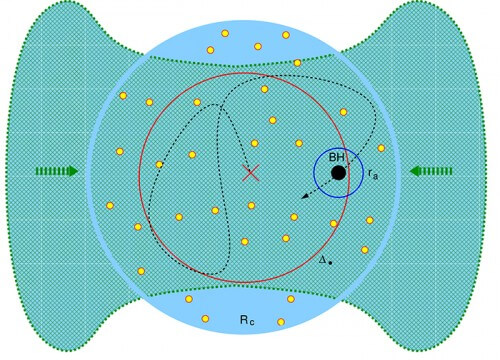A new model explains the formation process of supermassive black holes

In the outskirts of the universe there are huge black holes, whose mass is a billion times the mass of our sun. These celestial bodies, called "quasars", are constantly absorbing huge amounts of interstellar gas. The gas swallowed by the black hole loses energy which is emitted as light, which we see in telescopes after it has crossed the universe and reached us. Thus, when we observe a quasar, we are actually observing the past. The age of the universe today is about 14 billion years, while these quasars at the edge of the universe appear to us as they were less than a billion years after the big bang. That is, the relationship between today and the era of the ancient quasars is similar to the relationship between a 40-year-old adult and a two-year-old baby.
Astrophysicists who study black holes are already trying to understand how quasars got to their enormous size. The common formation mechanism of black holes is the collapse of a sun with several tens of solar masses into itself, when the stock of nuclear fuel in it runs out, and nothing stands against its self-gravity anymore. In this process, the star throws off a significant part of its mass in a supernova explosion, while the other part collapses into its own core and creates a black hole with a mass of10 Solar panels.
At this point, a question arises that has occupied astrophysicists since the discovery of the ancient quasars: How did a small black hole grow and develop into a giant quasar that weighed a billion solar masses and more in such a short time after the big bang? What is the mechanism that allows the original black hole to "swallow" such large amounts of matter and grow rapidly?
Here are two common processes that actually slow down the growth of the black hole: when the material does not move directly towards the mouth of the black hole, it can escape from it and go round and round around it. When the matter finally falls into the black hole, it compresses, rubs, heats up, and emits light that "pushes out". Gravity pulls, light pushes, and eventually an equilibrium is created that prevents the ingestion of additional matter into the black hole, retarding its growth.
If so, how did the quasars grow anyway? Prof. Tal Alexander, head of the department of particle physics and astrophysics at the Weizmann Institute of Science, recently proposed a solution to this problem - In the article which was published in the scientific journal Science Together with his research partner, Prof. Priyamvada Natharajan from Yale University.
The growth model - the feasibility of which Prof. Alexander showed - begins with the formation of a small black hole in the early universe. At that time, the gas streams in the universe were cold and dense, and contained much more matter compared to the sparse remnants of gas that remain in the universe today. The little black hole, newly born, moved and frequently changed the direction of its movement under the influence of other stars in the cosmic "nursery". These changes caused the gas to be unable to adapt to the rapid change and to enter a peripheral orbit around the black hole, and was engulfed within it. Thus the black hole absorbed large amounts of matter at an ever-increasing speed. Prof. Alexander explains that this is a growth rate that is faster than an exponential (super-exponential) rate. The period of accelerated growth lasted for10 million years (the blink of an eye in terms of the history of the universe), and at the end of it the black hole already had a mass equal to10,000 Solar panels. From then on the rate of growth slowed relatively, but the path of the black hole was already paved, leading it safely to quasar glory.

7 תגובות
A fascinating and interesting subject, the title certainly ignites the imagination.
"Want more..."
If it takes the sun 10 million years to reach a mass of 10,000 solar masses, then it grows at a rate of 1000 ms per million years, even if it continues to grow at this rate (and will not slow down as written in the article) it will reach 1,000,000 solar masses and not 9^10 Solar masses after a billion years as observed.
The fear of black holes is due to the human ego. For example, Israel is a poor country. But the leadership's ego does not allow it to give up an A+ credit rating. Thus, poverty does not decrease, it increases, and the purchasing power of Israelis decreases.
And here is another idea. Black holes merge with other black holes. And this is how a unification process is created, the longer it lasts, the bigger the black hole.
Nati
The restaurant at the edge of the universe - referring to time and not place.
One note:
There is no reason to think that the quasars are "at the edge of the universe". It is more likely that they are exactly in its center, and that the universe is "stretched" with equal information in our direction and in the other direction
To the editor: Sahtain on the title.